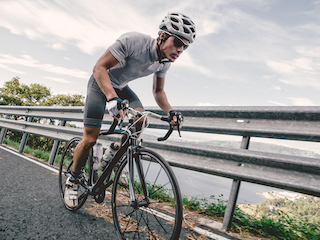
The short answer is, we’re simply not designed to maintain the same position for lengthy periods of time no matter what that position may be. Our muscles fatigue and tighten when they have maintained the same length for prolonged periods of time.
Neck pain from cycling is caused by looking up to see where we are going, causing neck hyperextension which is compounded by positional issues on the bike.
The head weighs approximately 7kg (the same as a ten pinball) and due to to the physics of leaning forwards when cycling, the “effective head weight” changes significantly which means it feels heavier. If we were to carry a heavy object on our head (for argument sake), it’s easier to carry it when our head is positioned over our shoulders not forwards of it, same weight, different effort… agreed?
Cycling completely changes the weight distribution of our head, loading our neck muscles and spinal structures, most importantly the neck nerves. When our core neck stabilising muscle groups become weak, tight or fatigued, they call upon their helpers (synergist) and when these ‘stand-in’ muscle groups fatigue, we experience pain in the back of the neck. This is often made worse when we brace ourselves cycling on uneven terrain, over gripping at high speeds, trying to stabilise ourselves when maximum effort is required going uphill or due to overall poor cycling technique causing us to sway from our lower trunk. Strained neck muscles and pinched nerves eventually develop.
All 16 neck (cervical) nerves originate and branch from our spinal cord (8 on each side). These nerves weave through curtains of muscles to form complex nerve plexuses in our armpit. Once the nerves leave the armpit they branch off into larger nerves which then continuously branch into smaller nerves reaching our fingertips. Most people would have heard of “carpal tunnel syndrome” which is entrapment of the Median nerve (one of the key branching nerves originating from our armpit). Most believe the entrapment occurs in the wrist but the fact is, the Median nerve can be entrapped at any point along its journey once it leaves the protection of the spinal canal. This is the reason why carpal tunnel surgery may fail to resolve finger numbness frustrating and disappointing the recipient.
Because neck nerves are the master controllers and regulators of neck muscles, if nerve entrapment is ignored (no matter how minor it may be) and does not become the treatment focal point, pain and numbness will persist. This is a key reason why treatment focusing only on muscles falls short of a proper solution.
MANAGEMENT & REHABILITATION
Manual therapy techniques will reduce pain and stiffness by restoring the natural movement of the cervical (neck) joints, reduce joint swelling (caused by aberrant joint movement), alleviate pressure and irritation to the adjacent nerves as well as the surrounding supporting soft tissue structures. Addressing both nerve and muscle dysfunction is the key to successfully treating this condition. Because nerves trigger muscles to over/under fire, focusing only on muscles does half the job. Don’t get me wrong, dealing directly with the affected muscles is still important but understanding the nerve is the boss and the muscle is the workers, puts things in better perspective when understanding how to successfully treat this condition.
When muscles are kept at the same length (isometric) by prolonged cycling positions, using trigger point therapy and deep soft tissue release techniques will relieve muscle spasm and improve flexibility. Appropriate stretches to maintain flexibility but more importantly, strengthening exercises to the deep neck flexors and shoulder girdle should be included in exercise programs for cyclists. It’s best to be prescribed specific exercises from your treating Chiro or Physio, as every individual is different and there may be other underlying pathology or previous injury such whiplash, osteoarthritis etc, that could be complicating the problem. Our Physiotherapists use an invaluable program called Physiotrack that offers crystal-clear, narrated exercise videos, delivered straight to a smartphone. It can work in real-time allowing progressive exercise changes instantly and streamlines communication throughout the various stages of recovery. It’s easy to use and offers up to date clinically verified exercises. Sounds perfect!
Our Physio can provide you with a rehab programme to manage your neck pain and help prevent it reoccurring. He can also offer valuable advice regarding your ergonomics in your daily activities and work. This is particularly important if you sit for hours at a computer or driving with your neck in a flexed position.
BODY CONDITIONING TIPS
A professional appraised exercise program is by far the best option but if you’re ready for that and just wanted to try a couple of things at home you could include lots of chin tucking exercises and mini sit-ups/crunches with your head. Because the neck muscles work together with the shoulder girdle, stabilising and strengthening the shoulder muscles is also important. Rowing type exercises with an emphasis on pulling the scapular back and together, as well as push-ups and many other exercises that include using Swiss balls and resistance bands could also be included.
If you want to access our Physio’s free Exercise Program for Cyclist send us an email with a few details about what you need help with and we will get back to you.
CYCLING TIPS
- If the handlebars are too low causing overreaching, shorten the stem
- Raise the bars and ride more upright to reduce the strain to the neck.
- Change hand positions at regular intervals
- Sit up on the bike to stretch & straightening to vary the loads on the different muscle groups
- Stretch your neck before & after every cycling session
- Hydrate properly for your body weight (multiply your kg X.03 e.g. 75kg X 0.03 = 2.25 litres/day)
- Get your neck assessed professionally so you get the right advice, treatment & exercise rehab program

